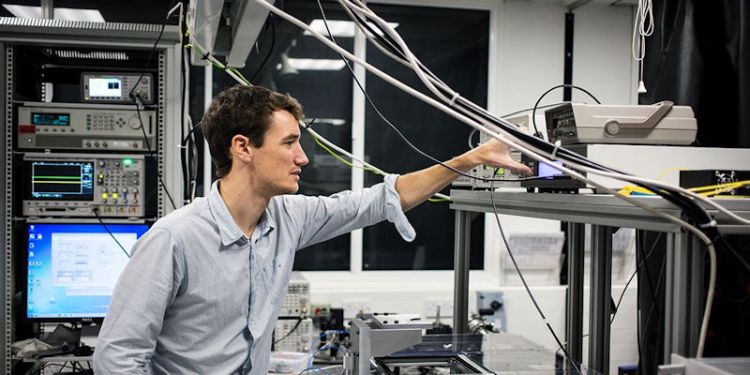Microwave and millimetre-wave engineering
Current research

Our current research projects are in the following areas:
Microwave filters and signal processing - Professor Hunter
Professor Hunter holds the Royal Academy of Engineering and Radio Design Ltd Chair in Microwave Signal Processing and is a leading authority on the theory and design of microwave filters. Current projects include the development of new classes of multimode dielectric resonator filters, integration of radiating and filtering functions in RF transceivers, development of theoretical synthesis techniques for combined filter-antenna subsystems and investigation of new classes of directional filters enabling multiple cellular operators to share antennas. Filters with tunable centre frequency and bandwidth are of considerable interest to the communications industry and a number of new topologies are being investigated.
Millimetre-wave system-in-package technology for integrated transceivers - Professor Robertson, Dr Somjit
This area includes modelling and design of multilayer circuit techniques, such as reconfigurable couplers, baluns, filters, antennas and substrate integrated waveguides in low-temperature co-fired ceramic (LTCC) technology. LTCC systems integration and micromachined components are studied at Leeds using laser-based prototyping. The fabrication of hollow waveguide and microfluidic structures in LTCC has attracted widespread interest. With this technology in hand, a wide range of millimetre-wave communications and sensing applications are being developed, including sensors for healthcare applications and exploration robotics.
High-frequency MEMS - Professor Robertson, Dr Steenson, Dr Somjit
These devices offer superior figure-of-merit compared to semiconductor circuits in terms of very low losses, high signal isolation, excellent linearity, virtually zero-power consumption, and extremely large bandwidth. Therefore, MEMS are near-ideal devices for high-performance, high-frequency systems and offer a broad spectrum of applications. Research activities in high-frequency MEMS at Leeds ranges from radio frequency (RF) to millimetre waves, and THz for various applications in e.g. high-performance wireless communication and, medical and biomedical systems. The research also includes novel material characterisation for millimetre and submillimetre-wave applications, as well as the development of novel planar and 3D micro/nano-fabrication techniques facilitated by state-of-the-art cleanroom and modern high-frequency measurement laboratory at Leeds.
Sub-millimetrewave detectors, mixers and amplifiers - Dr Steenson
Arrays of quantum barrier and heterostructure barrier varactor diodes and Schottky diodes have been used to form distributed slot-line transmission line structures on membranes for realizing broadband frequency triplers for use as CW and FMCW sources in sub-millimetre wave sub-systems. Sub-harmonic mixers are being developed for 300 GHz to 4 THz electronic systems, such as heterodyne detectors and detector arrays for applications in communication, spectroscopy and optics.
Measurement techniques - Mr Clarke
The group is home to the Roger Pollard High-Frequency Measurements Laboratory, supported by Agilent Technologies, which hosts the NPL/University of Leeds Millimetre-wave Test and Measurement Centre (MTMC). We are partners in the European Metrology Research Programme (EMRP) which is jointly supported by the European Commission and the European Association of National Metrology Institutes (EURAMET). The project has a broad remit, looking at traceability and measurement capability for several types of high-frequency measurements.
Metamaterials and electromagnetics - Professor Hunter, Dr Rhodes, Dr Snyder, Dr Somjit, Professor Robertson, Dr Steenson
The work on metamaterials, featured in the IEEE Microwave Magazine (Hunter et al., "Propagation and Negative Refraction", July-Aug. 2012) uses a new theory to explain the phenomenon of negative refraction in bulk metamaterials. Unlike earlier theories, this analysis does not rely on the existence of a single mode of propagation in materials with negative constitutive parameters. It is based on the interaction and phase reversal effects caused by the existence of two simultaneous electromagnetic (EM) modes in uniform inhomogeneous metamaterial structures. The theory has been applied both to quasi-lumped element microwave metamaterials and to optical negative refraction in bulk nanowire metamaterials and verified with EM simulations of microwave and optical metamaterials. The work on THz fibres, supported by Agilent Technologies, is comparing different microstructured fibres and has led to renewed interest in Bragg fibres as a means of realising a THz waveguide with exceptionally low loss for a wide range of applications. Experimental work is underway to characterise suitable low loss polymers and fabricate fibres with the optimum design, making use of Leeds' 1.1 THz PNA-X.
Further information
View all members of our research group and publications.
PhD projects
We have opportunities for prospective postgraduate researchers. Find out more.
Contact us
If you would like to discuss an area of research in more detail, please contact a relevant member of the research team.

